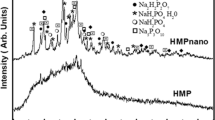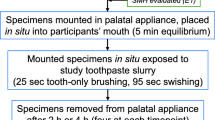Abstract
Objectives
This in vitro study evaluated the efficacy of toothpaste containing fluoride (F), sodium trimetaphosphate (TMP), and xylitol and erythritol (XE) to inhibit or repair initial enamel erosion lesions.
Materials and methods
Bovine enamel blocks (n = 120) were selected according to surface hardness (SH) and randomly divided into 5 experimental groups (n = 24 blocks/group): Placebo (no F, TMP, XE); 1100 ppm F; 16% xylitol + 4% erythritol (XE); 200 ppm F + 0.2% TMP (200 ppm F/TMP); and 200 ppm F + 0.2% TMP + 16% xylitol + 4% erythritol (200 ppm F/TMP/XE). The sound and softened blocks were immersed in toothpaste slurry in human saliva for 2 min. The blocks were then submitted to 4 erosive challenges in citric acid (0.75%, pH 3.5), each challenge for 1 min, with stirring. The SH of the blocks was determined after treatment (t) and after the 4 erosive challenges. In addition, the precipitates were analyzed by scanning electron microscopy (SEM). Variables were submitted to a two-way repeated-measures analysis of variance followed by a Student–Newman–Keuls test (p < 0.05).
Results
Toothpaste containing 200 ppm F/TMP/XE led to the highest protective and repair effect compared to the other groups (p < 0.001). The protective and repair effect was XE > 200 ppm F/TMP > 1100 ppm F > placebo (p < 0.001). All groups produced precipitates with a thicker layer for XE and TMP groups.
Conclusions
Toothpaste containing 200 ppm F, TMP, and polyols demonstrated a superior protective and repair effect in initial enamel erosive lesions in vitro.
Clinical relevance
Toothpaste containing F and polyols could be an advantage in patients affected by dental erosion, due to its higher preventive potential, mainly in individuals who frequently drink acidic beverages. However, future studies are needed to confirm these results.



Similar content being viewed by others
References
Buzalaf MA, Hannas AR, Kato MT (2012) Saliva and dental erosion. J Appl Oral Sci 20(5):493–502. https://doi.org/10.1590/s1678-77572012000500001
Lussi A, Schlueter N, Rakhmatullina E, Ganss C (2011) Dental erosion—an overview with emphasis on chemical and histopathological aspects. Caries Res 45(s1):2–12. https://doi.org/10.1159/000325915
Young A, Tenuta LMA (2011) Initial Erosion Models. Caries Res 45(1):33–42. https://doi.org/10.1159/000325943
Shellis RP, Featherstone JDB, Lussi A (2014) Understanding the chemistry of dental erosion. In: Lussi A, Ganss C (eds) Erosive tooth wear—from diagnosis to therapy, 2nd edn. Karger, Basel, pp 163–179
Lussi A, Megert B, Eggenberger D, Jaeggi T (2008) Impact of different toothpastes on the prevention of erosion. Caries Res 42(1):62–67. https://doi.org/10.1159/000112517
Turssi CP, Maeda FA, Messias DC, Neto FC, Serra MC, Galafassi D (2011) Effect of potential remineralizing agents on acid softened enamel. Am J Dent 24(3):165–168
Ponduri S, Macdonald E, Addy M (2005) A study in vitro of the combined effects of soft drinks and tooth brushing with fluoride toothpaste on the wear of dentine. Int J Dent Hyg 3(1):7–12. https://doi.org/10.1111/j.1601-5037.2004.00110.x
Magalhães AC, Rios D, Delbem AC, Buzalaf MA, Machado MA (2007) Influence of fluoride dentifrice on brushing abrasion of eroded human enamel: an in situ/ex vivo study. Caries Res 41(1):77–79. https://doi.org/10.1159/000096110
Barbour ME, Lussi A, Shellis RP (2011) Screening and prediction of erosive potential. Caries Res 45(Suppl 1):24–32. https://doi.org/10.1159/000325917
Walsh T, Worthington HV, Glenny AM, Marinho VC, Jeroncic A (2019) Fluoride toothpastes of different concentrations for preventing dental caries. Cochrane Database Syst Rev. 3:CD007868. https://doi.org/10.1002/14651858.CD007868.pub3
Moretto MJ, Magalhães AC, Sassaki KT, Delbem AC, Martinhon CC (2010) Effect of different fluoride concentrations of experimental dentifrices on enamel erosion and abrasion. Caries Res 44(2):135–140. https://doi.org/10.1159/000302902
Cruz NV, Pessan JP, Manarelli MM, Souza MD, Delbem AC (2015) In vitro effect of low-fluoride toothpastes containing sodium trimetaphosphate on enamel erosion. Arch Oral Biol 60(9):1231–1236. https://doi.org/10.1016/j.archoralbio.2015.05.010
Rochel ID, Souza JG, Silva TC, Pereira AF, Rios D, Buzalaf MA et al (2011) Effect of experimental xylitol and fluoride-containing dentifrices on enamel erosion with or without abrasion in vitro. J Oral Sci 53(2):163–168. https://doi.org/10.2334/josnusd.53.163
Cardoso CA, de Castilho AR, Salomão PM, Costa EN, Magalhães AC, Buzalaf MA (2014) Effect of xylitol varnishes on remineralization of artificial enamel caries lesions in vitro. J Dent 42(11):1495–1501. https://doi.org/10.1016/j.jdent.2014.08.009
Amaechi BT, Higham SM, Edgar WM (1998) The influence of xylitol and fluoride on dental erosion in vitro. Arch Oral Biol 43(2):157–161. https://doi.org/10.1016/s0003-9969(97)00109-x
Chunmuang S, Jitpukdeebodintra S, Chuenarrom C, Benjakul P (2007) Effect of xylitol and fluoride on enamel erosion in vitro. J Oral Sci 49(4):293–297. https://doi.org/10.2334/josnusd.49.293
Souza JG, Rochel ID, Pereira AF, Silva TC, Rios D, Machado MA et al (2010) Effects of experimental xylitol varnishes and solutions on bovine enamel erosion in vitro. J Oral Sci 52(4):553–559. https://doi.org/10.2334/josnusd.52.553
Amaral JG, Pessan JP, Souza JAS, Moraes JCS, Delbem ACB (2018) Cyclotriphosphate associated to fluoride increases hydroxyapatite resistance to acid attack. J Biomed Mater Res B Appl Biomater 106(7):2553–2564. https://doi.org/10.1002/jbm.b.34072
Marcato RA, Garbelini CCD, Danelon M, Pessan JP, Emerenciano NG, Ishikawa ADS et al (2021) In situ evaluation of 200 ppm fluoride toothpaste content trimetaphosphate, xylitol and erythritol on enamel demineralization and dental biofilm. J Dent 111:103724. https://doi.org/10.1016/j.jdent.2021.103724
Baumann T, Kozik J, Lussi A, Carvalho TS (2016) Erosion protection conferred by whole human saliva, dialysed saliva, and artificial saliva. Sci Rep 6:34760. https://doi.org/10.1038/srep34760
Wetton S, Hughes J, Newcombe RG, Addy M (2007) The effect of saliva derived from different individuals on the erosion of enamel and dentine. A study in vitro. Caries Res 41(5):423–426. https://doi.org/10.1159/000104802
Nekrashevych Y, Stösser L (2003) Protective influence of experimentally formed salivary pellicle on enamel erosion. An in vitro study. Caries Res 37(3):225–231. https://doi.org/10.1159/000070449
Schipper R, Loof A, de Groot J, Harthoorn L, Dransfield E, van Heerde W (2007) SELDI-TOF-MS of saliva: methodology and pre-treatment effects. J Chromatogr B Analyt Technol Biomed Life Sci 847(1):45–53. https://doi.org/10.1016/j.jchromb.2006.10.005
Jaeggi T, Lussi A (1999) Toothbrush abrasion of erosively altered enamel after intraoral exposure to saliva: an in situ study. Caries Res 33(6):455–461. https://doi.org/10.1159/000016551
Alencar CR, Mendonça FL, Guerrini LB, Jordão MC, Oliveira GC, Honório HM et al (2016) Effect of different salivary exposure times on the rehardening of acid-softened enamel. Braz Oral Res 30(1):e104. https://doi.org/10.1590/1807-3107BOR-2016.vol30.0104
Mendonça FL, Jordão MC, Val PP, de Alencar CR, Bassoto MA, Honório HM et al (2019) Eroded enamel rehardening using two intraoral appliances designs in different times of salivary exposure. J Clin Exp Dent 11(12):e1127–e1132. https://doi.org/10.4317/jced.56222
Hara AT, Zero DT (2008) Analysis of the erosive potential of calcium-containing acidic beverages. Eur J Oral Sci 116(1):60–65. https://doi.org/10.1111/j.1600-0722.2007.00513.x
Feagin F, Koulourides T, Pigman W (1969) The characterization of enamel surface demineralization, remineralization, and associated hardness changes in human and bovine material. Arch Oral Biol 14(12):1407–1417. https://doi.org/10.1016/0003-9969(69)90258-1
Cheng ZJ, Wang XM, Cui FZ, Ge J, Yan JX (2009) The enamel softening and loss during early erosion studied by AFM, SEM and nanoindentation. Biomed Mater 4(1):015020. https://doi.org/10.1088/1748-6041/4/1/015020
Stenhagen KR, Hove LH, Holme B, Taxt-Lamolle S, Tveit AB (2010) Comparing different methods to assess erosive lesion depths and progression in vitro. Caries Res 44(6):555–561. https://doi.org/10.1159/000321536
Danelon M, Takeshita EM, Sassaki KT, Delbem AC (2013) In situ evaluation of a low fluoride concentration gel with sodium trimetaphosphate in enamel remineralization. Am J Dent 26(1):15–20
Danelon M, Pessan JP, Santos VRD, Chiba EK, Garcia LSG, de Camargo ER et al (2018) Fluoride toothpastes containing micrometric or nano-sized sodium trimetaphosphate reduce enamel erosion in vitro. Acta Odontol Scand 76(2):119–124. https://doi.org/10.1080/00016357.2017.1388442
Magalhães AC, Wiegand A, Rios D, Honório HM, Buzalaf MAR (2009) Insights into preventive measures for dental erosion. J Appl Oral Sci 17(2):75–86. https://doi.org/10.1590/s1678-77572009000200002
Mäkinen KK, Söderling E (1984) Solubility of calcium salts, enamel, and hydroxyapatite in aqueous solutions of simple carbohydrates. Calcif Tissue Int 36(1):64–71. https://doi.org/10.1007/BF02405295
de Cock P, Mäkinen K, Honkala E, Saag M, Kennepohl E, Eapen A (2016) Erythritol is more effective than xylitol and sorbitol in managing oral health endpoints. Int J Dent 2016:9868421. https://doi.org/10.1155/2016/9868421
Imfeld T (1996) Prevention of progression of dental erosion by professional and individual prophylactic measures. Eur J Oral Sci. 104(2):215–220. https://doi.org/10.1111/j.1600-0722.1996.tb00070.x
Acknowledgements
We would like to thank the National Council for Technological and Scientific Development–Brazil (CNPq, grant number 133158/2019-5) for the master’s scholarship received by the first author; the State of São Paulo Research Foundation–Brazil (FAPESP, grant number 2018/21082-9) for the Scientific Initiation scholarship received by the fourth author; the Coordination for the Improvement of Higher Education Personnel–Brazil (CAPES, grant number 88881.068437/2014–2001) for financial support under the coordination of the second author; and Dr. Wayne Gundry from Xlear Incorporation (American Fork, UT, USA) for manufacturing the toothpastes.
Funding
The work was supported by the master’s scholarship received by the first author from the National Council for Technological and Scientific Development–Brazil (CNPq, grant number 133158/2019–5); the Scientific Initiation scholarship from the State of São Paulo Research Foundation–Brazil (FAPESP, grant number 2018/21082–9) received by the fourth author; and financial support from the Coordination for the Improvement of Higher Education Personnel–Brazil (CAPES, grant number 88881.068437/2014–2001) under the coordination of the second author.
Author information
Authors and Affiliations
Contributions
Priscila Toninatto Alves de Toledo and Amanda Eliane Sakamoto participated in the study design, performed the laboratory experiments, organized the data for statistical analysis, and contributed to the preparation of the manuscript. Mark Lloyd Cannon participated in validation, investigation, data curation, formal analysis, writing—review and editing. Alberto Carlos Botazzo Delbem conceived the study idea, funding acquisition, organized the data for statistical analysis, and contributed to the preparation of the manuscript. Denise Pedrini conceived the study idea, participated in the study design, supervised the laboratory experiments, organized the data for statistical analysis, and contributed to the preparation of the manuscript. All authors performed the revision and approval of the final version of the manuscript.
Corresponding author
Ethics declarations
Ethics approval
All procedures performed in studies involving human participants were in accordance with the ethical standards of the Institutional Review Board and with the 1964 Helsinki declaration and its later amendments or comparable ethical standards.
Informed consent
Informed consent was obtained from all individuals participating in the study.
Conflict of interest
The author Alberto Carlos Botazzo Delbem declares that he has a patent request in Brazil (INPI—BR 10 2020 022701 7) for “Dental Composition and Process of Obtaining it”. The authors Priscila Toninatto Alves de Toledo, Mark Lloyd Cannon, Amanda Eliane Sakamoto, and Denise Pedrini declare that they have no conflict of interest.
Additional information
Publisher's note
Springer Nature remains neutral with regard to jurisdictional claims in published maps and institutional affiliations.
Rights and permissions
Springer Nature or its licensor holds exclusive rights to this article under a publishing agreement with the author(s) or other rightsholder(s); author self-archiving of the accepted manuscript version of this article is solely governed by the terms of such publishing agreement and applicable law.
About this article
Cite this article
de Toledo, P.T.A., Delbem, A.C.B., Cannon, M.L. et al. The effect of toothpaste with reduced concentration of fluoride-containing sodium trimetaphosphate and polyols on initial enamel erosion. Clin Oral Invest 26, 7243–7252 (2022). https://doi.org/10.1007/s00784-022-04684-7
Received:
Accepted:
Published:
Issue Date:
DOI: https://doi.org/10.1007/s00784-022-04684-7




